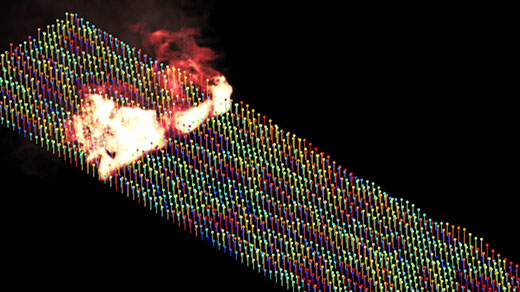Half a century ago, the pioneers of chaos theory discovered that the “butterfly effect” makes long-term prediction impossible. Even the smallest perturbation to a complex system (like the weather, the economy or just about anything else) can touch off a concatenation of events that leads to a dramatically divergent future. Unable to pin down the state of these systems precisely enough to predict how they’ll play out, we live under a veil of uncertainty.
copyright by www.quantamagazine.org
 But now the robots are here to help. In a series of results reported in the journals Physical Review Letters and Chaos , scientists have used machine learning — the same computational technique behind recent successes in artificial intelligence — to predict the future evolution of chaotic systems out to stunningly distant horizons. The approach is being lauded by outside experts as groundbreaking and likely to find wide application.
But now the robots are here to help. In a series of results reported in the journals Physical Review Letters and Chaos , scientists have used machine learning — the same computational technique behind recent successes in artificial intelligence — to predict the future evolution of chaotic systems out to stunningly distant horizons. The approach is being lauded by outside experts as groundbreaking and likely to find wide application.
“I find it really amazing how far into the future they predict” a system’s chaotic evolution, said Herbert Jaeger , a professor of computational science at Jacobs University in Bremen, Germany.
The findings come from veteran chaos theorist Edward Ott and four collaborators at the University of Maryland. They employed a machine-learning algorithm called reservoir computing to “learn” the dynamics of an archetypal chaotic system called the Kuramoto-Sivashinsky equation. The evolving solution to this equation behaves like a flame front, flickering as it advances through a combustible medium. The equation also describes drift waves in plasmas and other phenomena, and serves as “a test bed for studying turbulence and spatiotemporal chaos,” said Jaideep Pathak , Ott’s graduate student and the lead author of the new papers.
After training itself on data from the past evolution of the Kuramoto-Sivashinsky equation, the researchers’ reservoir computer could then closely predict how the flamelike system would continue to evolve out to eight “Lyapunov times” into the future, eight times further ahead than previous methods allowed, loosely speaking. The Lyapunov time represents how long it takes for two almost-identical states of a chaotic system to exponentially diverge. As such, it typically sets the horizon of predictability.
“This is really very good,” Holger Kantz, a chaos theorist at the Max Planck Institute for the Physics of Complex Systems in Dresden, Germany, said of the eight-Lyapunov-time prediction. “The machine-learning technique is almost as good as knowing the truth, so to say.”
The algorithm knows nothing about the Kuramoto-Sivashinsky equation itself; it only sees data recorded about the evolving solution to the equation. This makes the machine-learning approach powerful; in many cases, the equations describing a chaotic system aren’t known, crippling dynamicists’ efforts to model and predict them. Ott and company’s results suggest you don’t need the equations — only data. “This paper suggests that one day we might be able perhaps to predict weather by machine-learning algorithms and not by sophisticated models of the atmosphere,” Kantz said. […]
read more – copyright by www.quantamagazine.org
Thank you for reading this post, don't forget to subscribe to our AI NAVIGATOR!


Half a century ago, the pioneers of chaos theory discovered that the “butterfly effect” makes long-term prediction impossible. Even the smallest perturbation to a complex system (like the weather, the economy or just about anything else) can touch off a concatenation of events that leads to a dramatically divergent future. Unable to pin down the state of these systems precisely enough to predict how they’ll play out, we live under a veil of uncertainty.
copyright by www.quantamagazine.org
“I find it really amazing how far into the future they predict” a system’s chaotic evolution, said Herbert Jaeger , a professor of computational science at Jacobs University in Bremen, Germany.
The findings come from veteran chaos theorist Edward Ott and four collaborators at the University of Maryland. They employed a machine-learning algorithm called reservoir computing to “learn” the dynamics of an archetypal chaotic system called the Kuramoto-Sivashinsky equation. The evolving solution to this equation behaves like a flame front, flickering as it advances through a combustible medium. The equation also describes drift waves in plasmas and other phenomena, and serves as “a test bed for studying turbulence and spatiotemporal chaos,” said Jaideep Pathak , Ott’s graduate student and the lead author of the new papers.
After training itself on data from the past evolution of the Kuramoto-Sivashinsky equation, the researchers’ reservoir computer could then closely predict how the flamelike system would continue to evolve out to eight “Lyapunov times” into the future, eight times further ahead than previous methods allowed, loosely speaking. The Lyapunov time represents how long it takes for two almost-identical states of a chaotic system to exponentially diverge. As such, it typically sets the horizon of predictability.
“This is really very good,” Holger Kantz, a chaos theorist at the Max Planck Institute for the Physics of Complex Systems in Dresden, Germany, said of the eight-Lyapunov-time prediction. “The machine-learning technique is almost as good as knowing the truth, so to say.”
The algorithm knows nothing about the Kuramoto-Sivashinsky equation itself; it only sees data recorded about the evolving solution to the equation. This makes the machine-learning approach powerful; in many cases, the equations describing a chaotic system aren’t known, crippling dynamicists’ efforts to model and predict them. Ott and company’s results suggest you don’t need the equations — only data. “This paper suggests that one day we might be able perhaps to predict weather by machine-learning algorithms and not by sophisticated models of the atmosphere,” Kantz said. […]
read more – copyright by www.quantamagazine.org
Thank you for reading this post, don't forget to subscribe to our AI NAVIGATOR!
Share this: